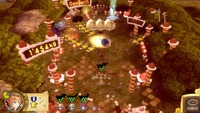|
|

|
PLATFORM
|
Vita
|
BATTLE SYSTEM
|

|
INTERACTION
|

|
ORIGINALITY
|

|
STORY
|

|
MUSIC & SOUND
|

|
VISUALS
|

|
CHALLENGE
|
Adjustable
|
COMPLETION TIME
|
Less than 20 Hours
|
|
OVERALL

|
+ Great use of classical music.
+ Big world to explore and interact with.
- Story is one gigantic cliché.
- Bland, pasty visuals.
- New mechanics strip away the challenge.
- Is it a sequel or a remake?
|
Click here for scoring definitions
|
|
|
Back in 2009, RPGamer was pleasantly enamored by a niche little Wii game called Little King's Story. It rapidly drew a large following among our staff, and was narrowly beaten out by Demon's Souls for our game of the year award. It showcased a whimsical world filled to bursting with imaginative, quirky characters, and a charming story that carried with it a childlike wonderment that is rarely seen in video games. It remains in many RPGamers eyes, this one included, as the best game on the platform. It may be disappointing to hear, then, that New Little King's Story, the recently released sequel on the PlayStation Vita, completely fails to recapture that charm, instead settling for questionable gameplay tweaks, reused settings, and a laughable, by-the-numbers story that is utterly shamed by its predecessor's.
In a bizarre twist of convention, New Little King's Story is part sequel, part remake, and sadly the game could have been much improved had it simply chosen to be one or the other. Instead, players are saddled with gameplay they've already experienced coupled with a story nobody could possibly care about. New Little King's Story seems to take place several years after the first game, or possibly in place of the first game; it's quite ambiguous on this point. Regardless, King Corobo, the youthful protagonist of the original title, has grown into the strapping teenage ruler of Alpoko Kingdom. As the game begins, his castle is invaded by demons, and Corobo along with some of his guards are forced to flee. At the same time, seven pillars of blue light appear all over the kingdom. Having escaped from the siege, Corobo sets up a new base of operations and proceeds to rebuild his kingdom and investigate the pillars, all in hopes of eventually taking back his castle.
If this sounds like the set-up for a bad anime, you'd be right. New Little King's Story seems to completely miss the point of the original title, twisting its charming tale of childhood escapism into a generic fantasy story. It abandons the unique art style in favor of anime tropes and bland, pasty character models. Even returning characters seem to have been sidelined in favor of more traditional, anime ones. Most offensive by far, however, is Azul, a pretty-boy newcomer who takes over from the loveable Howser as head of Corobo's military. Howser is still around, but has virtually no role in the story, his position effectively usurped for no other apparent reason than that he doesn't fit the anime cliché. Other returning characters are only given brief cameos, and Skinny Ray, who played an important role in the original, isn't even introduced, despite the fact that he can be found roaming around town. The princesses from the previous game have similarly been modified from their original, unique designs, reimagined and in some cases outright replaced by typical anime tropes, including a Shinto priestess, a Japanese school girl, a loli, a pop idol, and even a robot battle-girl. All the originality and creativity has been completely gutted and replaced with cynical, board-room designed clichés.
 Ninjas!
Ninjas!
|
|
The mechanics of New Little King Story should be familiar to anyone who's played the original, or the Overlord or Pikmin series. Players take control of King Corobo, whose job it is to systematically rebuild his kingdom. He does this by leading his citizens out on expeditions to hunt monsters or search for treasure. Players can recruit townsfolk by speaking with them, and change their jobs by sending them into specific buildings scattered around the kingdom. Each of the game's many jobs has a unique use, and more become available as the kingdom expands. Soldiers are effective combatants, able to deal more damage than usual to monsters, animal hunters can fire arrows at out-of-reach enemies, farmers are good at digging up treasure, lumberjacks and miners can destroy certain obstacles, carpenters can build things, and cooks can instantly kill poultry. There are also a number of unique, one-shot classes that have their own special capabilities.
Gameplay is simple but allows for a lot of strategy. Corobo leads his royal guard out into the wild where monsters and treasure are waiting to be found and hauled back to town to expand the kingdom. The square button fires the next guardsman along a straight line, interacting with whatever obstacle lies in its path. The entire guard can be called back to the king with the circle button, and using these two simple mechanics, players can attack and evade enemies until they bring them down. Most monsters get little fumes of smoke above their heads when they're about to attack, so players always have plenty of time to react and get their guardsmen out of the way. Despite its simplicity, the gameplay is quite solid and easy to get into, and its slow pace makes for a fairly relaxing tempo. King Corobo can also accept quests from his throne room, which are given to him by the townspeople. While some of these quests are merely padding for players to supplement their income, several important sidequests become available, including long-term collection quests granted by each princess, and mini-bosses that must be defeated in order to unlock new areas for building.
Unfortunately, New Little King's Story reuses almost all of the content from its predecessor. Players visit the same locations and even fight several of the same bosses, and where the areas do differ, the replacement content isn't nearly as interesting. A few of the more infuriating bosses from Little King's Story have thankfully been dismantled and all of them seem to be much brisker than before, but what appears in their place, with one exception, completely lack imagination and aren't that much different from normal enemies. The game even forces players to revisit each area at the end in order to fight a new boss, none of which exhibit the creativity seen in the first game. In fact, two of these new bosses are identical, and merely larger versions of a normal enemy players will encounter in the game.
 The pinball boss is one of several that made it into the sequel unaltered.
The pinball boss is one of several that made it into the sequel unaltered.
|
|
New Little King's Story does throw a few new mechanics into the mix, but their benefit is questionable. The most notable change is the addition of equipment for the royal guard. Monsters and quests will often lead to the discovery of weapons and armor which can be manually equipped to Corobo's royal guardsmen, improving their damage and life and even changing their appearance. While this is certainly the natural next step for the game, it has the unfortunate side effect of making it much, much easier. As the game progresses, Corobo's guardsmen will do so much damage and have so much life that the odds of death are negligible. The game also introduces a number of consumable items which can be used to restore life points to the entire guard in the middle of battle, yet another feature that reduces the challenge significantly. In addition, the princesses can now accompany Corobo into battle, each making use of a unique ability. Unfortunately, they cannot be added to the royal guard and must be manually recruited every time one wishes to set out, and their abilities are limited anyways. Most players won't want to bother with them. An alchemy system has also been added, making use of some limited online connectivity, but most players won't find any need to make use of it.
Like its predecessor, New Little King's Story mostly makes use of classical music for its soundtrack, though there are several unique compositions in the mix as well. There's a limited amount of voicework, but unfortunately it's of fairly low quality and in short supply. The visuals are decent, but as previously stated, the over-reliance on anime tropes and drab art style don't really stand out in any way. Worse, the game suffers from significant slowdown when the screen is overrun with characters. This becomes an ongoing problem once the royal guard increases in size, though thankfully the gameplay is slow-paced enough to not be significantly affected.
It's rather difficult to imagine how a game as unique and inspired as Little King's Story turned into this. Although the game is solid enough for players to get some enjoyment out of it, it's impossible to recommend it over the Wii original. Whether it's a sequel or a remake, it's disappointing on every level. It's also somehow shorter, likely due to the streamlined boss battles, clocking in at anywhere between fifteen and twenty hours. An adjustable difficulty level may also help to alleviate the damage done to the game's balance by the new systems. If you're desperate for a portable Little King's Story experience, New Little King's Story should sate your appetite, but be warned: little Corobo's all grown up, and he's lost his imagination.
Review Archives
|









